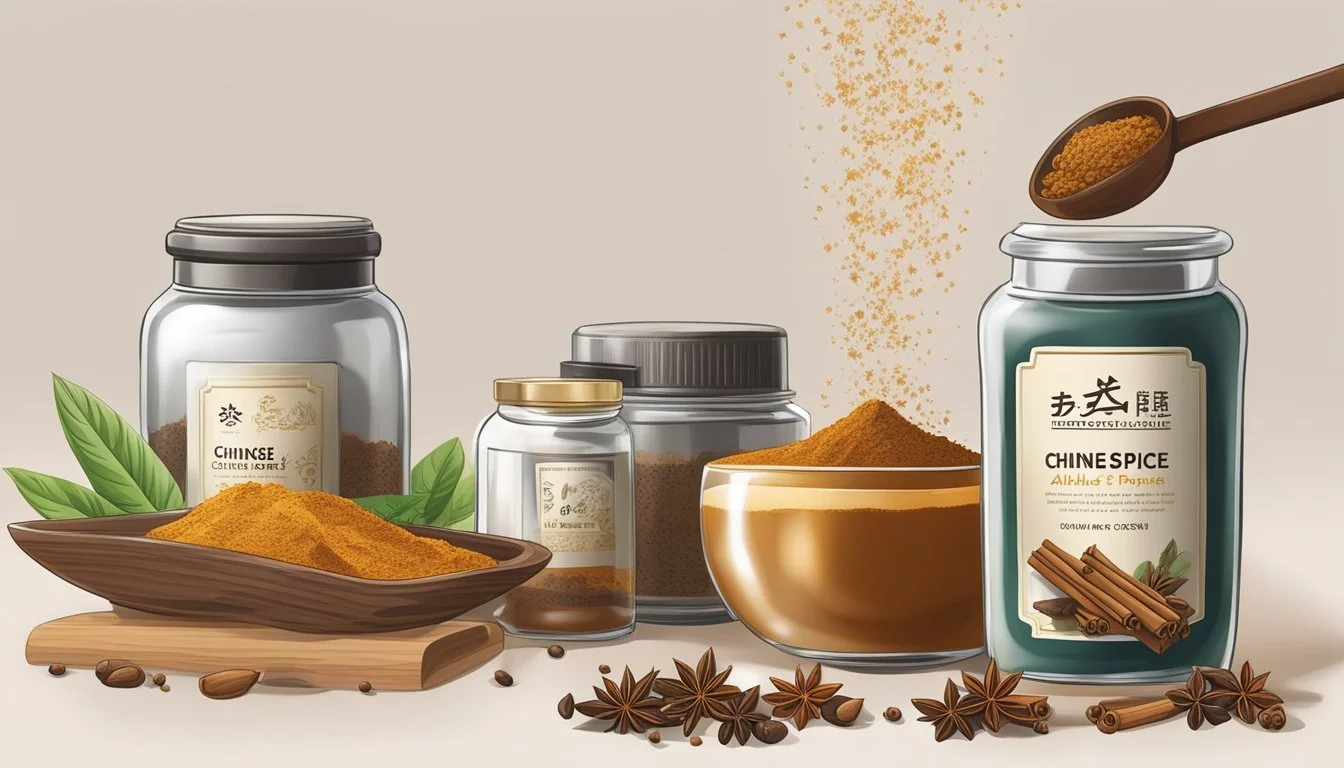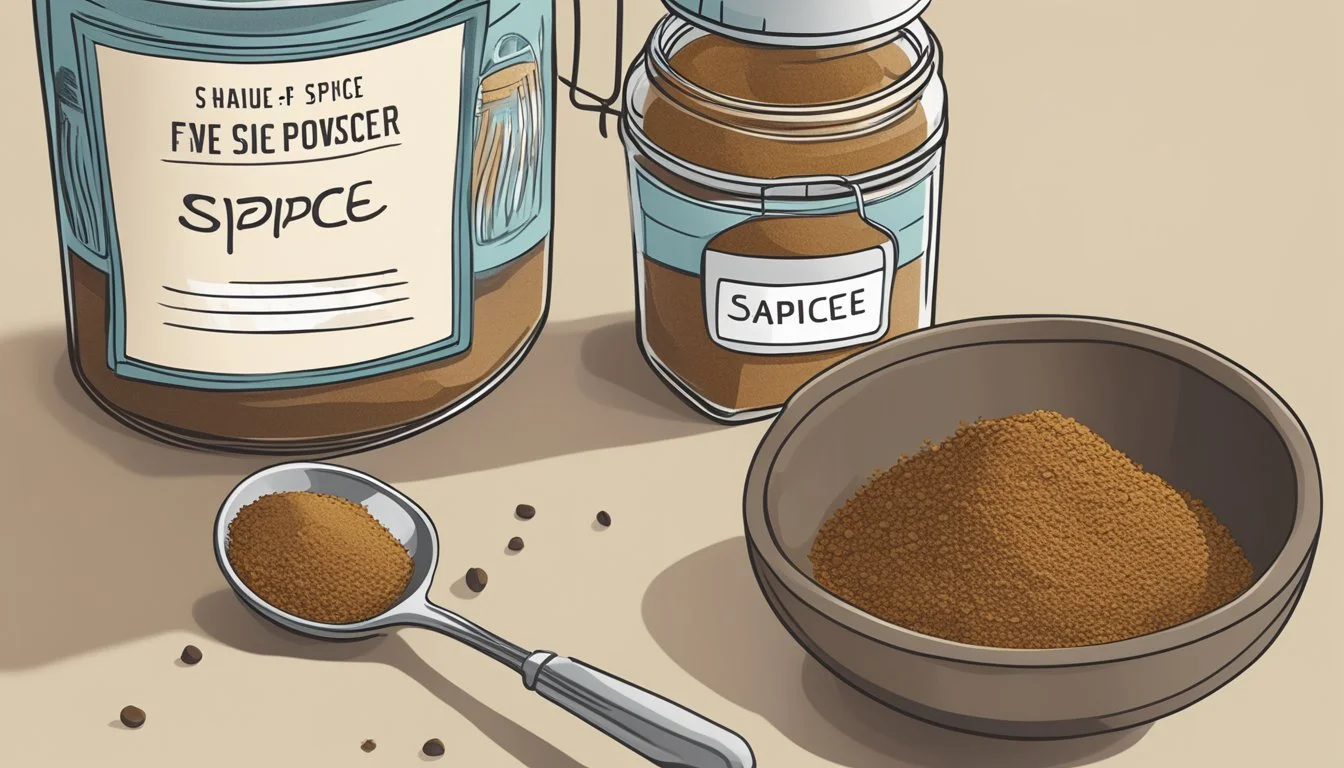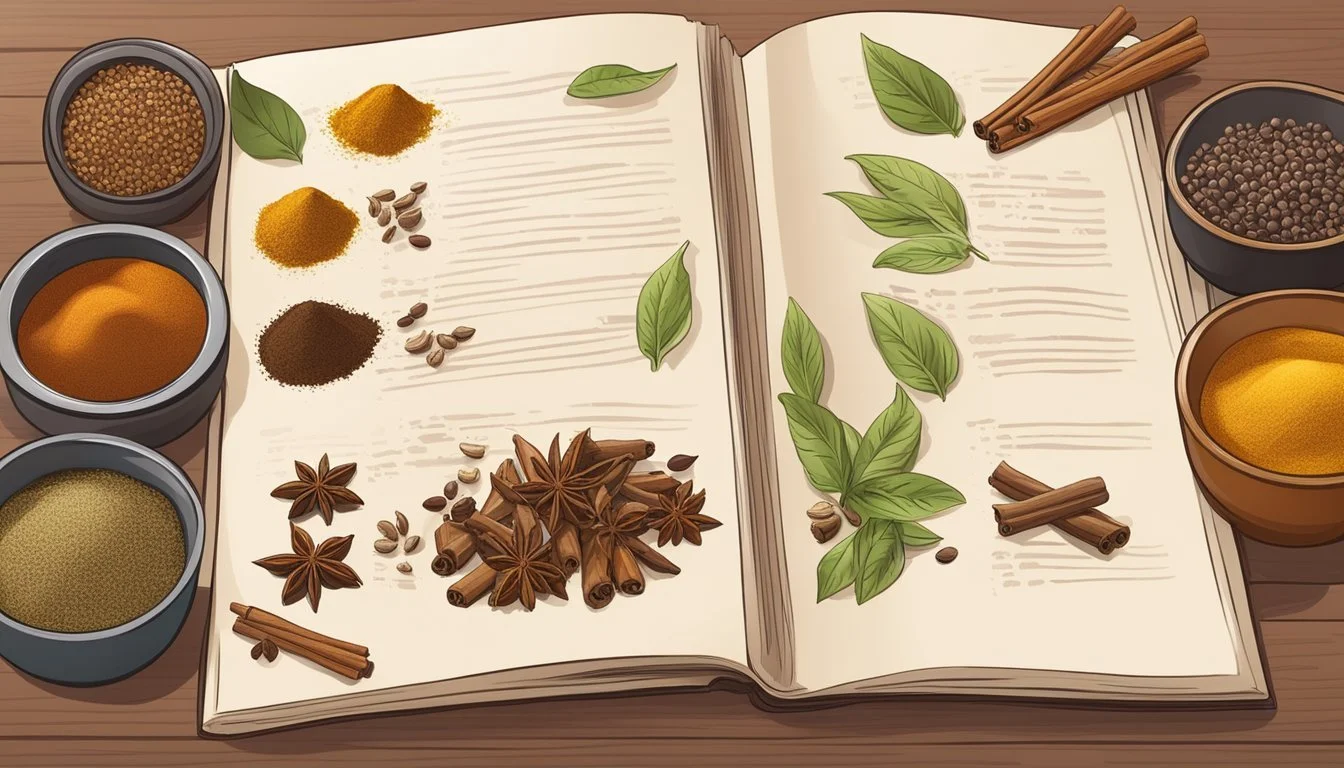How to Substitute Chinese Five-Spice Powder for Allspice
A Simple Guide
Chinese five-spice powder is a cornerstone of Asian cooking, imparting a distinct aromatic blend that is sweet, spicy, and warm due to its unique combination of cinnamon, cloves, fennel seeds, star anise, and Sichuan peppercorns. Its complex flavor profile is challenging to replicate, yet there are occasions when a substitute must be found, whether due to availability issues or personal preference. Allspice, known for its singular ability to mimic the flavors of several spices, emerges as a potential stand-in.
Despite their different cultural origins, allspice bears a flavor that surprisingly resembles the warming notes of Chinese five-spice. Originating from the berry of the Pimenta dioica plant, allspice has notes of cinnamon, cloves, and nutmeg, providing a comparable warmth and depth to dishes. While allspice lacks the licorice hint of star anise and the slight peppery kick from Sichuan peppercorns, its versatility makes it a viable option when one seeks an alternative without compromising the integrity of the dish’s intended flavor palette.
When substituting Chinese five-spice with allspice, chefs should consider the balance of flavors within the recipe. Allspice's singular note can complement the other ingredients, but it may require careful pairing with additional spices to achieve the desired complexity. The goal is not to recreate Chinese five-spice, but rather to bring a harmonious blend that resonates with the original spice's spirit.
Understanding Chinese Five-Spice Powder
Chinese five-spice is a quintessential spice blend that plays a pivotal role in many Asian dishes. Renowned for its uniquely bold and balanced mix, it comprises five primary ingredients that are considered to bring harmony to a dish's flavor profile. Here's a snapshot of the classic components:
Star anise: offers a sweet, licorice-like flavor
Cloves: yields a warming and pungent taste
Fennel seeds: provides a light licorice essence
Cinnamon: imparts a sweet and woody note
Sichuan peppercorns: create a distinctive tingling sensation
Chinese five-spice combines these ingredients in varying proportions to form a powdery seasoning that holds an aromatic, sweet, and pungent flavor. It's an adaptable blend that can be used to season meats, stir-fries, and even some desserts. The allure of Chinese five-spice rests in its ability to contribute depth to a dish's flavor. Its sweet undertones stem primarily from cinnamon and star anise, while cloves and Sichuan peppercorns introduce warmth and a mild kick. Fennel seeds round off the experience with a touch of herbaceous sweetness.
Every ingredient in the mix serves a purpose. As a cohesive unit, they lend complex notes to recipes, which are difficult to replicate with other singular spices. However, in the absence of this blend, understanding its components helps in creating an alternative that achieves a similar multifaceted flavor profile.
Allspice Flavor Characteristics
Allspice is a prominent spice known for its robust and complex flavor profile that stands distinct among other spices. It derives from the dried berries of the Pimenta dioica plant. The name "allspice" was coined because its taste is said to resemble a blend of cinnamon, nutmeg, and cloves.
The flavor of allspice can be described through several attributes:
Sweetness: Allspice bears a noticeable sweet undertone, which is reminiscent of cinnamon.
Aromatic: It possesses a warm, aromatic fragrance, which adds a deep, comforting note to dishes.
Spicy notes: There is a subtle heat to allspice, akin to nutmeg, which can add a spicy kick without being overpowering.
Describing its richness in the context of basic taste sensations:
Sweet: These aspects come forward due to the intrinsic sweetness alluded to above.
Sour: There's typically no sourness associated with allspice.
Bitter: While not predominantly bitter, there can be a mild bitter note that adds depth to its profile.
Salty: Allspice does not have a salty flavor, but it complements salty foods well.
Regarding its role as a flavoring agent, allspice is quite flavorful and versatile, making it suitable for a range of dishes, from sweet to savory. Its usage spans different cuisine styles where complex spice layers are desired.
In summary, allspice carries a unique combination of flavors that can simulate the multifaceted essence of Chinese five-spice powder, particularly through its sweet and warm spicy characteristics. It serves as an appropriate substitute when used judiciously to maintain balance within a dish's overall flavor spectrum.
Culinary Uses of Chinese Five-Spice and Allspice
Chinese five-spice is an essential seasoning blend in East Asian cooking, revered for its ability to impart a complex, aromatic flavor to a range of dishes. It typically consists of cinnamon, cloves, fennel, star anise, and Sichuan peppercorns. Chefs often use it to season meats such as duck and pork, and it's a key ingredient in many Chinese recipes. Additionally, it can enhance the flavor of stews and soups.
On the other hand, allspice is a single spice that derives from the dried berries of the Pimenta dioica plant and carries a taste reminiscent of cinnamon, nutmeg, and cloves. It plays a prevalent role in Caribbean and Middle Eastern cuisines and is often found in recipes calling for a warm and sweet note.
Chinese Five-Spice Allspice Flavor Profile Flavor Profile Warm Warm and sweet Complex Nuanced Slightly spicy Mildly peppery Culinary Applications Culinary Applications Meats, especially duck Jerk seasoning Stews Dessert spice Marinades Soups Soups Meat seasoning
To toast Chinese five-spice, chefs typically warm the whole spices in a dry pan until aromatic before grinding them into a powder. This process enhances the oil release and deepens the flavors. Allspice, while often sold ground, can also be toasted in whole berry form to achieve a similar effect of intensified taste.
Both spices offer a way to add a layers of flavor to a dish. When substituting allspice for Chinese five-spice, one should use it sparingly as it lacks the same heat that comes from Sichuan peppercorns and anise tones from the star anise.
Key Ingredients in Five-Spice and Allspice
The blend of Chinese five-spice powder typically harnesses the aromatic and distinctive flavors of five key ingredients. These include star anise, which imparts a licorice-like sweetness; cinnamon, known for its warm and woody notes; fennel seeds, with their mild aniseed flavor; cloves, adding a strong, pungent taste; and Sichuan peppercorns (not included in the list above), contributing a unique numbing spice.
Allspice, despite its name suggesting a blend, is a single spice. It comes from the dried berries of the Pimenta dioica plant. The flavor profile of allspice closely resembles a mixture of spices, particularly nutmeg, cinnamon, and cloves. This resemblance makes it a plausible substitute for a variety of spices or blends, including the Chinese five-spice.
Below is a comparison of key ingredients in both spices:
Chinese Five-Spice Allspice Star anise -- Cinnamon Cinnamon Fennel seeds -- Cloves Cloves Sichuan peppercorns -- -- Nutmeg
While allspice does not contain all the components of the five-spice, its inclusion of cinnamon and cloves may provide a similar warmth in dishes. The definitive flavors such as star anise and fennel are missing, which could be supplemented with anise seed or ground fennel to better mimic the original Chinese blend. However, flavors from spices like nutmeg, which are not traditionally present in five-spice, may introduce a slight variation to the taste profile. In addition, while allspice lacks the heat from Sichuan peppercorns, it compensates with a subtle peppery note.
How to Substitute Five-Spice for Allspice
When a recipe calls for allspice and none is on hand, Chinese five-spice powder can serve as a substitute due to its complex, warm flavor profile. However, it's important to note that while these spice blends share common ingredients, they are not identical in taste.
Chinese five-spice, a blend of cinnamon, cloves, fennel seeds, star anise, and Sichuan peppercorns, offers a more pungent and aromatic flavor. One should consider the dish's compatibility with these flavors before substituting. To ensure balance, start with a smaller amount of five-spice than allspice and adjust to taste. A good starting ratio is about half the amount of five-spice to the allspice called for in the recipe, as the five-spice is generally more potent.
For more authentic results, especially in Middle Eastern recipes that traditionally use allspice, one may create a homemade blend more similar to allspice by selectively using the components within Chinese five-spice. For example:
Cinnamon and cloves, found in both blends, can be used in equal parts.
A pinch of ground fennel seeds adds the sweet note akin to allspice.
Chinese Five-Spice Components Suggested Ratio as Allspice Substitute Cinnamon 1 part Cloves 1 part Fennel Seeds A pinch (optional)
Adjust the blend to suit the dish and personal taste preferences, bearing in mind the boldness of five-spice. Remember that the goal is to complement the other ingredients without overpowering them.
Exploring Alternate Spice Substitutes
When a recipe calls for Chinese five-spice powder and none is at hand, alternative spice blends can be used effectively to mimic its complex flavor. One may consider garam masala, a blend revered in Indian cuisine which can provide warmth similar to Chinese five-spice. The blend typically includes cumin, coriander, cardamom, and other spices, offering a balance of sweet and savory notes.
Garam Masala: Use ½ teaspoon combined with ¼ teaspoon of star anise powder to substitute for 1 teaspoon of five-spice.
Baharat is another blend of spices, originating from the Middle East. Its ingredients, including cumin, paprika, nutmeg, and cinnamon, parallel many elements of Chinese five-spice.
Baharat: Can be used in a 1:1 ratio as a substitute for five-spice.
Za'atar, another Middle Eastern condiment, though not as closely related in flavor to five-spice, can still be considered for its herbal notes and toasty sesame seeds.
Za’atar: Should be used sparingly and is best when the recipe can welcome its distinct thyme-like flavor.
Cardamom and coriander are excellent single-spice substitutes. They are part of both garam masala and baharat, and they contribute to the flavor profile with their floral and citrusy notes respectively.
Cardamom: Works best when supplemented with other spices like cinnamon or nutmeg.
Coriander: Pair with clove and cinnamon for a more rounded substitute.
When selecting a substitute, it’s important to consider the primary ingredients of the blend one is using. Modify the quantity and combination based on the central flavors of the dish to achieve a comparable depth and aroma to that provided by Chinese five-spice powder.
DIY Spice Blends
Creating a homemade blend to substitute Chinese five-spice powder for allspice involves a balance of savory and sweet spices. One needs a spice blender, either a dedicated electric grinder or a mortar and pestle, to achieve a fine consistency, especially when starting with whole spices.
To begin, toasting the spices enhances their flavor. A dry pan over medium heat suffices, stirring constantly for even toasting until the spices release a flavorful aroma. This is particularly important for cinnamon sticks and anise seeds, which are tougher and benefit from the heat to release oils.
Below is a simple blend utilizing the core components that mimic the complex taste of allspice:
Quantity Spice 1 tsp Ground cinnamon 1 tsp Ground cloves 1 tsp Ground fennel ½ tsp Ground anise ¼ tsp Ground pepper
Combine these ingredients thoroughly, adjusting quantities to taste. For a closer approximation to allspice, one may consider adding a pinch of ground nutmeg and a hint of ground ginger. This blend will encapsulate the warming, sweet-yet-savory profile that allspice imparts in recipes.
Cultural Significance and Origins
Chinese five-spice powder is deeply rooted in the culinary traditions of southern China. It embodies the philosophy of balance in Chinese cuisine, striving to incorporate the five basic flavors of sweet, sour, bitter, pungent, and salty. This spice blend typically consists of star anise, cloves, Chinese cinnamon, Sichuan peppercorns, and fennel seeds. Each ingredient contributes to the complex flavor profile that is characteristic of many Chinese dishes.
In comparison, allspice, often associated with the Middle East and also used in some Moroccan dishes, is a single spice that tastes like a combination of cloves, nutmeg, and cinnamon. It is also prevalent in Western cooking, particularly in baking and as a seasoning for meats.
Cultural Significance:
Chinese five-spice: Symbolizes the balance of yin and yang in food.
Allspice: Used in Middle Eastern and Moroccan cuisine, it conveys the warmth of the regions' aromatic cooking style.
The spice section in markets within southern China often features five-spice powder prominently. Its usage can be traced back to traditional Chinese medicine, where the combination of spices was said to have healing properties.
Origins:
Chinese five-spice: Originated from southern China, with each spice selected for its medicinal benefits as well as its flavor.
Allspice: Although it is used in Middle Eastern and Moroccan cuisines, it originates from the New World, specifically the Caribbean and Central America, and was brought to Europe by the Spanish.
The use of these spices goes beyond seasoning and is interwoven with the cultural fabric and historical traditions of their respective regions. They are not just culinary ingredients but also carry with them stories and practices of the places where they are cherished.
Pairing Spices with Food
When substituting Chinese five-spice powder with allspice, one must consider the flavor profile of the dish. Allspice, while not identical, is a singular spice that echoes some of the warm, sweet notes found in five-spice powder. It’s a versatile spice that can be used in various dishes to add depth and complexity.
Soups and Stews: Allspice pairs well with rich, hearty stews and soups, imbuing them with a warm, aromatic essence without overwhelming the dish's inherent flavors. It complements both meat-based and vegetarian recipes, contributing to a balanced umami characteristic.
Meat Dishes: For rubs and marinades, allspice can be combined with other spices to mimic the broader flavor spectrum of five-spice powder. Here's a simple guideline:
Meat Type Suggested Seasonings Beef Allspice, garlic, and a touch of cinnamon or clove Pork Allspice and ginger for a warm, spicy note Poultry Allspice with a dash of nutmeg and black pepper Fish Allspice and lemon zest for brightness
Each combination is crafted to respect the unique taste of the meat while introducing complementary seasonings to enhance the overall flavor.
Vegetarian Dishes (What wine goes well with vegetarian dishes?): In vegetable dishes or grains, allspice can be added to create an underlying note of warmth. The spice harmonizes with root vegetables, such as carrots and sweet potatoes, and is gentle enough to season delicate grains like rice or quinoa.
When using allspice as a substitute in a dish traditionally calling for Chinese five-spice, chefs should start with a conservative amount. They can then adjust to taste, ensuring the allspice's pungency does not overpower the dish's intended flavor profile.
Storing Spices for Freshness
When storing herbs and spices, maintaining their freshness is crucial for preserving their flavor and aroma. Here are some best practices for storage:
Location: Store your spices in a cool, dark place away from direct sunlight. Heat, light, and moisture can cause spices to lose their potency.
Containers: Opt for airtight containers to protect spices from humidity and other contaminants. Glass jars with tight-fitting lids are commonly used and effective.
Whole vs Ground: Whole spices tend to retain their freshness longer than ground spices due to their reduced surface area. Consider investing in a spice grinder to grind whole spices as needed, which can optimize their texture and flavor.
Labeling: Clearly label each container with the spice name and the date of purchase or grinding. This practice helps in tracking their shelf life.
Usage: Rotate your spices periodically. Use older spices before newer ones, and avoid storing spices for excessively long periods, even if they are whole.
Handling: Always use dry utensils when measuring out spices to prevent introducing moisture into the containers.
Here is a concise table summarizing the storage tips for optimal freshness:
Spice Form Container Location Handling Usage Whole Spices Airtight, opaque Cool, dark place Dry utensils only Grind as needed Ground Spices Airtight, opaque Dark cabinet or drawer Keep containers sealed Use older stock first Herbs Airtight, opaque Refrigerator (if fresh) Minimize exposure Use within 6 months
By following these guidelines, chefs and home cooks alike can ensure their spices, including commonly used ones like allspice or Chinese five-spice powder, remain vibrant, and contribute the desired flavor profiles to their dishes.










